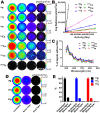Molecular optical imaging with radioactive probes
- PMID: 20208993
- PMCID: PMC2830426
- DOI: 10.1371/journal.pone.0009470
Molecular optical imaging with radioactive probes
Abstract
Background: Optical imaging (OI) techniques such as bioluminescence and fluorescence imaging have been widely used to track diseases in a non-invasive manner within living subjects. These techniques generally require bioluminescent and fluorescent probes. Here we demonstrate the feasibility of using radioactive probes for in vivo molecular OI.
Methodology/principal findings: By taking the advantages of low energy window of light (1.2-3.1 eV, 400-1000 nm) resulting from radiation, radionuclides that emit charged particles such as beta(+) and beta(-) can be successfully imaged with an OI instrument. In vivo optical images can be obtained for several radioactive probes including 2-deoxy-2-[(18)F]fluoro-D-glucose ([(18)F]FDG), Na(18)F, Na(131)I, (90)YCl(3) and a (90)Y labeled peptide that specifically target tumors.
Conclusions/significance: These studies demonstrate generalizability of radioactive OI technique. It provides a new molecular imaging strategy and will likely have significant impact on both small animal and clinical imaging.
Conflict of interest statement
Figures






References
-
- Massoud TF, Gambhir SS. Molecular imaging in living subjects: seeing fundamental biological processes in a new light. Genes Dev. 2003;17:545–580. - PubMed
-
- Gambhir SS. Molecular imaging of cancer with positron emission tomography. Nat Rev Cancer. 2002;2:683–693. - PubMed
-
- Weissleder R. Molecular imaging in cancer. Science. 2006;312:1168–1171. - PubMed
-
- Weissleder R. Scaling down imaging: molecular mapping of cancer in mice. Nat Rev Cancer. 2002;2:11–18. - PubMed
-
- Weissleder R, Ntziachristos V. Shedding light onto live molecular targets. Nat Med. 2003;9:123–128. - PubMed
Publication types
MeSH terms
Substances
Grants and funding
LinkOut - more resources
Full Text Sources
Other Literature Sources
Medical

